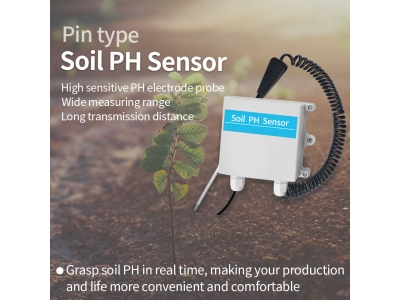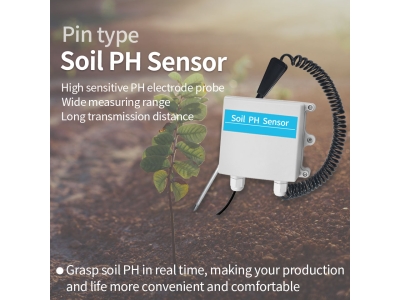
From Data to Action: Leveraging Soil Sensor Information for Improved Agricultural Productivity
soil sensor technology has emerged as a powerful tool to gather real-time data on soil conditions and enable farmers to make informed decisions.

soil sensor technology has emerged as a powerful tool to gather real-time data on soil conditions and enable farmers to make informed decisions.
Agriculture is a vital industry that provides food and resources for the growing global population. With the increasing demand for sustainable food production, it has become imperative to optimize agricultural practices for improved productivity and resource efficiency. In recent years, soil sensor technology has emerged as a powerful tool to gather real-time data on soil conditions and enable farmers to make informed decisions. By leveraging soil sensor information, farmers can enhance their understanding of soil health, optimize irrigation and fertilization practices, and ultimately improve agricultural productivity. This article explores the process of turning soil sensor data into actionable insights and its impact on agricultural productivity.

Understanding Soil Sensor Technology:
Soil sensors are devices designed to measure various parameters of the soil, such as moisture content, temperature, pH level, salinity, and nutrient levels. These sensors are strategically placed within agricultural fields to collect data on soil conditions. The collected data is then analyzed to gain insights into the soil's health and nutritional status.
Collecting and Analyzing Soil Sensor Data:
The first step in leveraging soil sensor information is the collection of accurate and reliable data. Soil sensors continuously monitor the selected parameters and transmit the data wirelessly to a central database or a cloud-based platform. The data is then processed and analyzed using advanced data analytics techniques.
Data Quality Assurance: Ensuring data accuracy and reliability is crucial for making informed decisions. Soil sensors must be regularly calibrated against reference standards to maintain accuracy. Quality control measures should be implemented to identify and mitigate any potential errors or outliers in the data.
Data Integration: Soil sensor data can be combined with other relevant data sources, including weather forecasts, satellite imagery, and crop models. Integration of multiple data streams provides a comprehensive understanding of the field's dynamics and facilitates data-driven decision-making.
Advanced Analytics: Advanced data analytics techniques, such as machine learning and artificial intelligence, can be applied to soil sensor data to extract valuable insights. These techniques help identify complex patterns, predict crop performance, and provide personalized recommendations for farmers.
Translating Data into Actionable Insights:
The ultimate goal of leveraging soil sensor information is to transform raw data into actionable insights that drive improved agricultural productivity. This involves converting data into meaningful information and recommendations that farmers can use to optimize their farming practices. Here are some key applications of soil sensor information:
Precision Irrigation: Soil sensors provide real-time data on soil moisture levels, enabling farmers to optimize irrigation practices. By understanding the moisture content at different depths and locations within a field, farmers can tailor their irrigation schedules and amounts to match the specific needs of the crops. This precision irrigation approach minimizes water wastage, reduces energy costs, and ensures optimal crop growth.
Targeted Fertilization: Nutrient sensors measure the concentration levels of essential nutrients in the soil. By analyzing nutrient data from soil sensors, farmers can accurately assess nutrient deficiencies or excesses. This information allows for precise fertilization practices, ensuring that crops receive the right amount of nutrients at the right time. Targeted fertilization maximizes nutrient uptake, minimizes fertilizer waste, and improves crop quality and yield.
Soil Health Monitoring: Soil sensors provide valuable information about soil pH, salinity, and temperature. By monitoring these parameters, farmers can identify potential issues such as soil acidity or alkalinity, salinity build-up, or extreme temperature conditions. Early detection of these problems allows farmers to take timely corrective actions, preventing crop damage and yield losses.
Decision Support Systems: Integration of soil sensor data with decision support systems enables farmers to receive real-time recommendations tailored to their specific field conditions. These systems use algorithms and models to analyze the data and generate actionable insights. For example, a decision support system can suggest optimal planting dates, crop varieties, or disease prevention strategies based on soil sensor data and other relevant parameters.
Benefits of Leveraging Soil Sensor Information:
The utilization of soil sensor information offers numerous benefits to farmers and the agricultural industry as a whole:
Improved Resource Efficiency: By optimizing irrigation and fertilization practices based on soil sensor data, farmers can reduce water consumption and minimize fertilizer waste. This leads to significant cost savings and environmental sustainability.
Enhanced Crop Productivity: By providing real-time insights into soil conditions, soil sensors help farmers create optimal growing conditions for their crops. This leads to improved crop health, increased productivity, and higher-quality produce.
Risk Mitigation: Soil sensors enable farmers to detect and address potential issues early on, such as nutrient deficiencies, salinity build-up, or extreme temperature conditions. Timely interventions minimize crop losses and improve overall yield stability.
Data-Driven Decision Making: Leveraging soil sensor information allows farmers to make informed decisions based on empirical data rather than relying on guesswork or generalized recommendations. This data-driven approach enhances precision agriculture practices and optimizes resource allocation.
Challenges and Considerations:
While leveraging soil sensor information holds great promise, several challenges need to be addressed:
Cost and Accessibility: The initial investment and ongoing costs associated with soil sensor technology may pose barriers, particularly for small-scale farmers. Efforts are needed to develop affordable sensor solutions and provide support, training, and incentives to make soil sensors accessible to all farmers.
Data Management and Integration: Managing and integrating large volumes of data from multiple soil sensors can be complex. Farmers require appropriate data management systems, robust connectivity, and user-friendly interfaces to effectively utilize the data and translate it into actionable insights.
Scalability and Adaptability: Soil sensor technology needs to be scalable and adaptable to different soil types, climatic conditions, and crop varieties. Solutions should be flexible enough to accommodate diverse agricultural systems and provide accurate recommendations across various contexts.
Education and Awareness: Farmers need to be educated about the benefits and applications of soil sensor technology. Training programs and awareness campaigns can help farmers understand the value of soil sensor information and its potential impact on their farming practices.
Conclusion:
Leveraging soil sensor information has the potential to revolutionize agricultural practices and contribute to improved productivity, resource efficiency, and sustainability. By collecting and analyzing real-time data on soil conditions, farmers can make informed decisions regarding irrigation, fertilization, and other crucial aspects of crop management. The translation of soil sensor data into actionable insights enables precision agriculture practices, reduces resource wastage, and enhances overall crop health and yield. As soil sensor technology continues to advance and become more accessible, it holds great promise for the future of agriculture, paving the way for a more sustainable and food-secure world.